

Mughal architecture is the type of Indo-Islamic architecture developed by the Mughals in the 16th, 17th and 18th centuries throughout the ever-changing extent of their empire in the Indian subcontinent. It developed from the architectural styles of earlier Muslim dynasties in India and from Iranian and Central Asian architectural traditions, particularly Timurid architecture.[3][4][5][6][7] It also further incorporated and syncretized influences from wider Indian architecture, especially during the reign of Akbar (r. 1556–1605).[3][4][6][7] Mughal buildings have a uniform pattern of structure and character, including large bulbous domes, slender minarets at the corners, massive halls, large vaulted gateways, and delicate ornamentation; examples of the style can be found in modern-day Afghanistan, Bangladesh, India and Pakistan.
The Mughal dynasty was established after the victory of Babur at Panipat in 1526. During his five-year reign, Babur took considerable interest in erecting buildings, though few have survived. His grandson Akbar built widely, and the style developed vigorously during his reign. Among his accomplishments were Agra Fort, the fort-city of Fatehpur Sikri, and the Buland Darwaza. Akbar's son Jahangir commissioned the Shalimar Gardens in Kashmir.
Mughal architecture reached its zenith during the reign of Shah Jahan, who constructed Taj Mahal, the Jama Masjid of Delhi, the Shalimar Gardens of Lahore, and renovated the Lahore Fort. High-ranking officials below the emperor were also able to build major monuments, as with the example of the Wazir Khan Mosque. The last of the great Mughal patrons was Aurangzeb, who built the Badshahi Mosque, Bibi Ka Maqbara, Moti Masjid etc.
Background
Mughal emperors and elites consciously used architecture as a way to publicly display their presence and power. The extensive architectural patronage of the Mughals was made possible by their considerable wealth, which exceeded that of other contemporary Muslim empires like the Ottomans and Safavids.[8] In the Indian subcontinent, more monuments survive from the Mughal period than any other period.[8] Major monuments of this time include mosques, mausoleums, palaces, gardens, and fortresses.[9]

Mughal architecture was derived from three main architectural traditions: local Indo-Islamic architecture, the architecture of Islamic Persia and Central Asia, and indigenous Hindu architecture.[4] Because earlier Indo-Islamic architecture already borrowed from both Hindu and Islamic architectural styles, certain influences in Mughal architecture can be difficult to attribute to one source or the other. With regards to Hindu architecture, local Rajput palaces were likely a key influence.[4] Early Mughal architecture developed from existing Indo-Islamic architecture while following the model of Timurid architecture (based in Central Asia), due in part to the Timurid ancestry of the Mughal dynasty's founder, Babur.[3][9][6][7] By the late 16th century, a more distinctive Mughal tradition emerged based on the combination of these two sources.[7]
Under the reign of Akbar (r. 1556–1605), the use of Hindu architectural elements was especially prolific, including in high-profile construction projects like Fatehpur Sikri. Under his successors, there was a shift towards more typically Islamic architectural designs.[3] Under Akbar in particular, non-Muslims were present among the highest-ranking officials and were able to become patrons of architecture as well. The most notable example is Raja Man Singh, a Hindu amir who built both Hindu temples and Muslim mosques and shrines.[7]
During the reign of Shah Jahan (r. 1628–1658), a "classical" Mughal style was consolidated and remained essentially in use until the end of the Mughal period.[7] A certain level of stylistic consistency was achieved throughout the empire at this period thanks to the role of a central department of architects, similar to the imperial architects that existed in the Ottoman Empire.[9]
Mughal architecture has also influenced later Indian architectural styles, including the Indo-Saracenic style of the British Raj, the Rajput style and the Sikh style. One scholar has also noted similarities between Mughal architecture and architectural projects within the Ethiopian Empire in the early 17th century, primarily those sponsored by Susenyos I and carried out with the help of the Jesuit missionaries that he patronized. This influence was likely due to the strong connections between the Jesuit missions in Ethiopia and Mughal India at the time. Indian craftsmen, possibly with experience in Mughal constructions, are also reported to have worked on the projects.[10]
Characteristics
General
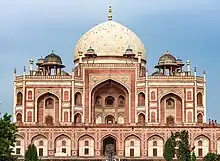
Mughal architecture is distinguished by an elegant style in which careful linear divisions of spaces and surfaces took priority over the more three-dimensional combination of elements that distinguished earlier Indo-Islamic architecture.[9] The use of colour was also relatively restrained, with emphasis instead on finishing surfaces with high-quality, polished materials. Bulbous domes and ogive arches were among the most prominent recurring elements.[9] In addition to domes and arches, the local tradition of trabeate construction also continued, especially in secular architecture like palaces.[9]
Another distinguishing characteristic was the use of red sandstone as a building material, along with white marble. This replaced the prominence of brick in earlier Indo-Islamic architecture,[9] though construction materials still varied depending on the region.[4] Sandstone is a very hard material, but local Indian stonemasons were skilled in carving it with intricate detail, which was another distinguishing feature of the Mughal style. White marble was initially used as a cladding to compliment and finish the look of sandstone buildings, as in Humayun's Tomb, but later it was used on a grander scale to cover entire buildings, as in the Taj Mahal.[4] Brick was sometimes still used for domes and arches, but in these cases it was usually faced with plaster or stone as a finish.[4]
Decoration

Decorative motifs included geometric and floral designs, as well as elaborate inscriptions in Arabic, Persian, and even in local languages during the late Mughal period.[11] Decoration was commonly executed in tile or stone.[4]
Tilework was more commonly applied to the exterior of buildings and existed in two main types: cuerda seca and mosaic tilework. Cuerda seca tiles were decorated with coloured glazes separated by dark lines, while mosaic tilework consisted of single-coloured tile pieces that were cut and fitted together to create larger patterns.[4]
Stonework was of high quality and marks one of the most sophisticated aspects of Mughal decoration. Carved stonework included ornately-sculpted pillars and corbels, flat panels carved in low relief with depictions of flowers, and pierced marble screens known as jalis.[4] Pietra dura, known as parchin kari in the Indian subcontinent,[12] was the technique of decorating with inlaid stone. It developed in this region independently from the Italian technique that is widely known elsewhere.[4]
Influences
.jpg.webp)
Elements of earlier Indo-Islamic architecture that continued in Mughal architecture are the cusped (multifoil) arches, which appeared earlier in the architecture of Delhi and Gujarat, as well as the do-chala roof, a feature originating in Bengali architecture that was adopted in the architecture of the Bengal Sultanate.[4]
Features of Persian or Central Asian (Timurid) influence were the iwan (a vaulted space open to one side), the use of domes, the pointed four-centred arch, the use of decorative tilework, and the chahar bagh type of garden, along with various other motifs and building layouts.[4] In dome construction, Persian-style squinches were used in some cases, but in other cases the domes were supported by flat beams over the corners of the chamber.[4]

Elements of Mughal architecture that demonstrate Hindu influences include the use of trabeate constructions, the use of corbel arches instead of arches with voussoirs, and the style of ornately-carved pillars.[4] Jharokhas (projecting balconies), chhatris (domed kiosks), and chhajjas (wide stone eaves) are also elements that were borrowed from local Hindu architecture and became very popular in Mughal architecture. Some elements, such as projecting balconies, had parallels in Islamic architecture elsewhere but their specific Mughal forms were of local inspiration.[4]
Major building types

Large fortified citadels or palace complexes, such as the Agra Fort and the Red Fort in Delhi, were enclosed in massive walls reinforced by semi-circular towers and entered via monumental gateways. Inside, the classic Mughal palace was laid out with symmetrical gardens and various pavilions. Open pavilions with rows of cusped arches were a recurring feature. Rich decoration was used to embellish rooms and halls.[4]
Gardens were a favourite concern of Mughal emperors, whether they were created as separate, dedicated garden sites or as the setting for pavilions and mausoleums within larger architectural complexes. They were laid out in a formal manner with terraces, precise divisions, and water features.[4]
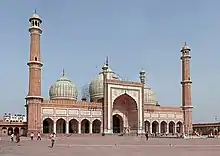
Mosques were relatively more restrained in their decoration but were built on a grand scale. The typical mosque layout in the classic Mughal era involved a large rectangular courtyard surrounded by an arcade on three sides and a prayer hall on one side. The prayer hall consisted of a wide vaulted hall fronted by an arcade of monumental arches, with the central archway consisting of a larger iwan rising above the others.[4]
The most monumental and elaborate Mughal structures were royal mausoleums, deliberately designed to show off the power and sophistication of their patrons. The classic Mughal tomb was an octagonal or rectangular structure with a central dome and outer iwans, raised on a terraced platform.[4]
Other public buildings and infrastructure works included roads, milestones (known as kos minar), caravanserais (inns for merchants and travelers), and bridges. These were more functional in nature and less decorative, though some caravanserais were embellished with elaborate gateways.[4]
Monuments
Babur

The architectural patronage of Babur, the first Mughal emperor, is mainly known for its terraced gardens. These gardens, often established in palaces and citadels, were modeled on the Persian chahar bagh ("four gardens") type, in which gardens are geometrically divided into different plots, usually four equal parts. This type followed Timurid antecedents, though the use of water channels as linear dividers may have been a Mughal innovation.[9] Babur himself was initially buried at Agra, but in 1644 his tomb was moved to one of his favourite gardens in Kabul, now known as the Gardens of Babur.[8]
In religious architecture, Babur's mosques also followed the designs of earlier Timurid mosques, with a tall central entrance portal (pishtaq), a courtyard, and a prayer hall covered by a large central dome flanked by side aisles covered by smaller domes. An example of this is his mosque at Panipat.[9][7]
Akbar
Agra Fort
Agra fort is a UNESCO World Heritage Site in Agra, Uttar Pradesh. The major part of Agra fort was built by Akbar from 1565 to 1574. The architecture of the fort clearly indicates the free adoption of the Rajput planning and construction. Some of the important buildings in the fort are Jahangiri Mahal built for Jahangir and his family, the Moti Masjid, and Mena Bazaars. The Jahangiri Mahal has a courtyard surrounded by double-storeyed halls and rooms.
Humayun's Tomb

Humayun's tomb is the tomb of the Mughal Emperor Humayun in Delhi, India. The tomb was commissioned by Humayun's first wife and chief consort, Empress Bega Begum (also known as Haji Begum), in 1569–70, and designed by Mirak Mirza Ghiyas and his son, Sayyid Muhammad, Persian architects chosen by her. It was the first garden-tomb on the Indian subcontinent. It is often regarded as the first mature example of Mughal architecture.
Fatehpur Sikri

Akbar's greatest architectural achievement was the construction of Fatehpur Sikri, his capital city near Agra at a trade and Jain pilgrimages.[13][14][15] The construction of the walled city was started in 1569 and completed in 1574.
It contained some of the most beautiful buildings – both religious and secular which testify to the Emperor's aim of achieving social, political and religious integration. The main religious buildings were the huge Jama Masjid and small Tomb of Salim Chisti. Buland Darwaza, also known as the Gate of Magnificence, was built by Akbar in 1576 to commemorate his victory over Gujarat and the Deccan. It is 40 metres high and 50 metres from the ground. The total height of the structure is about 54 metres from ground level.
The Haramsara, the royal seraglio in Fatehpur Sikri was an area where the royal women lived. The opening to the Haramsara is from the Khwabgah side separated by a row of cloisters. According to Abul Fazl, in Ain-i-Akbari, the inside of Harem was guarded by senior and active women, outside the enclosure the eunuchs were placed, and at a proper distance there were faithful Rajput guards.[16]
Jodha bai Palace is the largest palace in the Fatehpur Sikri seraglio, connected to the minor haramsara quarters. The main entrance is double storied, projecting out of the facade to create a kind of porch leading into a recessed entrance with a balcony. Inside there is a quadrangle surrounded by rooms. The columns of rooms are ornamented with a variety of Hindu sculptural motifs.
Tomb of Salim Chisti
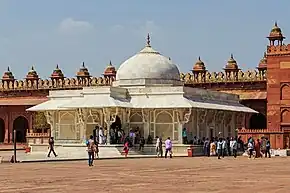
The Tomb of Salim Chishti is famed as one of the finest examples of Mughal architecture in India, built during the years 1580 and 1581. The tomb, built in 1571 in the corner of the mosque compound, is a square marble chamber with a verandah. The cenotaph has an exquisitely designed lattice screen around it. It enshrines the burial place of the Sufi saint, Salim Chisti (1478 – 1572), a descendant of Khwaja Moinuddin Chishti of Ajmer, who lived in a cavern on the ridge at Sikri. The mausoleum, constructed by Akbar as a mark of his respect for the Sufi saint, who foretold the birth of his son.
Jahangir
Begum Shahi Mosque

The Begum Shahi Mosque is an early 17th-century mosque situated in the Walled City of Lahore, Pakistan. The mosque was built between 1611 and 1614 during the reign of Mughal Emperor Jahangir by his mother, Mariam-Uz-Zamani,[17][18][19] and is Lahore's earliest dated Mughal-era mosque.[20][17][21] It is known for its exquisite fresco decoration of geometric and floral motifs painted on stucco, along with inscriptions of the names of God.[20][17][21] The mosque would later influence construction of the larger Wazir Khan Mosque a few decades later.[22]
Tomb of I'timād-ud-Daulah

The tomb of I'timād-ud-Daulah, is a mausoleum in the city of Agra in the Indian state of Uttar Pradesh. Often described as a "jewel box", sometimes called the "Bachcha Taj", as the tomb of I'timād-ud-Daulah is often regarded as a draft of the Taj Mahal.
Shah Jahan
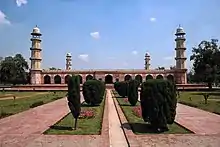
Rather than building huge monuments like his predecessors to demonstrate their power, Shah Jahan built elegant monuments. The force and originality of this previous building style gave way under Shah Jahan to a delicate elegance and refinement of detail, illustrated in the palaces erected during his reign at Agra, Delhi and Lahore. Some examples include the Taj Mahal at Agra, the tomb of his wife Mumtaz Mahal, under the chief architect Ustad Ahmad Lahori, a Punjabi Muslim.[23][24][25] The Moti Masjid (Pearl Mosque) in the Agra Fort and the Jama Masjid at Delhi, the latter built under the supervision of his Grand Vizier, Saadullah Khan, a Punjabi Muslim,[26] are imposing buildings of his era, and their position and architecture have been carefully considered so as to produce a pleasing effect and feeling of spacious elegance and well-balanced proportion of parts. Shah Jahan also renovated buildings such as the Moti Masjid, Sheesh Mahal and Naulakha pavilion, which are all enclosed in the Lahore Fort. He also built a mosque named after himself in Thatta called Shahjahan Mosque (not built in the Mughal architecture, but in Safavid and Timurid architecture that were influenced by the Persian architecture). Shah Jahan also built the Red Fort in his new capital at Shah Jahanabad, now Old Delhi. The red sandstone Red Fort is noted for its special buildings-Diwan-i-Aam and Diwan-i-Khas. Another mosque was built during his tenure in Lahore called Wazir Khan Mosque, by Shaikh Ilm-ud-din Ansari who was the court physician to the emperor. It is famous for its rich embellishment which covers almost every interior surface. Overall public works by high nobles of Shah Jahan's amirs included Ali Mardan Khan, Ilmuddin Wazir Khan, Khan-i Dauran Nasiri Khan, and Kartalab Khan Deccani.[27]
Taj Mahal
The Taj Mahal, a World Heritage Site was built between 1632 and 1653 by the emperor Shah Jahan in memory of his wife Mumtaz Mahal .[1] Its construction took 22 years and required 22,000 laborers and 1,000 elephants, at a cost of 32 million rupees. (corresponding to US$ 827 million in 2015) It is a large, white marble structure standing on a square plinth and consists of a symmetrical building with an iwan (an arch-shaped doorway) topped by a large dome and finial.
The building's longest plane of symmetry runs through the entire complex except for the sarcophagus of Shah Jahan, which is placed off centre in the crypt room below the main floor. This symmetry is extended to the building of an entire mirror mosque in red sandstone, to complement the Mecca-facing mosque placed to the west of the main structure. Parchin kari, a method of decoration on a large scale-inlaid work of jewels and Jali work has been used to decorate the structure.
Wazir Khan Mosque

The Wazir Khan Mosque was commissioned during the reign of the Mughal Emperor Shah Jahan in 1634, and completed in 1642.[28] Considered to be the most ornately decorated Mughal-era mosque,[29] Wazir Khan Mosque is renowned for its intricate faience tile work known as kashi-kari, as well as its interior surfaces that are almost entirely embellished with elaborate Mughal-era frescoes. The mosque has been under extensive restoration since 2009 under the direction of the Aga Khan Trust for Culture and the Government of Punjab.[30]
Shalimar Gardens
It is a Mughal garden complex located in Lahore, capital of the Pakistani province of Punjab. The gardens date from the period when the Mughal Empire was at its artistic and aesthetic zenith.[31] Construction of the gardens began in 1641 during the reign of Emperor Shah Jahan,[32] and was completed in 1642.[33] In 1981 the Shalimar Gardens were inscribed as a UNESCO World Heritage Site as they embody Mughal garden design at the apogee of its development.[31]
Shah Jahan Mosque

The Shah Jahan Mosque is the central mosque for the city of Thatta, in the Pakistani province of Sindh. The mosque commissioned by Shah Jahan, who bestowed it to the city as a token of gratitude.[34] Its style is heavily influenced by Central Asian Timurid architecture, which was introduced after Shah Jahan's campaigns near Balkh and Samarkand.[34] The mosque is considered to have the most elaborate display of tile work in South Asia,[34][35] and is also notable for its geometric brick work - a decorative element that is unusual for Mughal-period mosques.[36]
Shahi Hammam

Shahi Hammam is a Persian-style bath which was built in Lahore, Pakistan, in 1635 C.E. during the reign of Emperor Shah Jahan. It was built by chief physician to the Mughal Court, Ilam-ud-din Ansari, who was widely known as Wazir Khan.[37][38][39] The baths were built to serve as a waqf, or endowment, for the maintenance of the Wazir Khan Mosque.[40]
Aurangzeb
In Aurangzeb's reign (1658–1707) squared stone and marble was replaced by brick or rubble with stucco ornament. Srirangapatna and Lucknow have examples of later Indo-Mughal architecture. He made additions to the Lahore Fort and also built one of the thirteen gates which were later named after him (Alamgir).
Badshahi Mosque
.jpg.webp)
The Badshahi Mosque in Lahore, Pakistan, was commissioned by the sixth Mughal Emperor Aurangzeb. Constructed between 1673 and 1674, it is the largest Mughal mosque and the last of the imperial mosques to be built.[2] The mosque is adjacent to the Lahore Fort and is the last in the series of congregational mosques in red sandstone. The red sandstone of the walls contrasts with the white marble of the domes and the subtle intarsia decoration. Aurangzeb's mosque's architectural plan is similar to that of his father, Shah Jahan, the Jama Masjid in Delhi; though it is much larger. It also functions as an idgah. The courtyard which spreads over 276,000 square feet, can accommodate one hundred thousand worshippers; ten thousand can be accommodated inside the mosque. The minarets are 196 feet (60 m) tall. The Mosque is one of the most famous Mughal structures but suffered greatly under the reign of Maharaja Ranjit Singh. In 1993, the Government of Pakistan included the Badshahi Mosque in the tentative list for UNESCO World Heritage Site.[41]
Additional monuments
Additional monuments from this period are associated with women from Aurangzeb's imperial family. The construction of the elegant Zinat al-Masjid in Daryaganj was overseen by Aurangzeb's second daughter Zinat-al-Nissa. Aurangzeb's sister Roshan-Ara who died in 1671. The tomb of Roshanara Begum and the garden surrounding it were neglected for a long time and are now in an advanced state of decay.
Bibi ka Maqbara

Bibi Ka Maqbara was a mausoleum built by Emperor Aurangzeb, in the late 17th century as a loving tribute to his first wife, Dilras Bano Begum in Aurangabad, Maharashtra. Some accounts suggest that later it was taken care by Azam Shah, son of aurangzeb. It is a replica of the Taj Mahal, and was designed by Ata-Ullah, the son of Ahmed Lahori, who was the principal designer of the Taj Mahal.
Late Mughal
Lalbagh Fort

Lalbagh Fort (also known as "Fort Aurangabad"), a Mughal palace fortress at the Buriganga River in the southwestern part of Dhaka, Bangladesh, whose construction started in 1678 during the reign of Aurangzeb's son Azam Shah.
Sunehri Mosque

Sunehri Mosque is a late Mughal-era mosque in the Walled City of Lahore, Pakistan. Sunehri Mosque was built in 1753 when the empire was in decline, during the reign of Muhammad Shah.
Tomb of Safdar Jang
The Tomb of Safdar Jung completed in 1754 is one of the last examples of Mughal Architecture.
Gardens
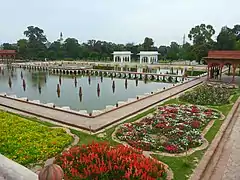
Mughal gardens are gardens built by the Mughals in the Islamic style. This style was influenced by Persian gardens. They are built in the char bagh structure, which is a quadrilateral garden layout based on the four gardens of Paradise mentioned in the Qur'an. This style is intended to create a representation of an earthly utopia in which humans co-exist in perfect harmony with all elements of nature.[42]
The quadrilateral garden is divided by walkways or flowing water into four smaller parts. Significant use of rectilinear layouts are made within the walled enclosures. Some of the typical features include pools, fountains and canals inside the gardens.
Some famous examples of Mughal gardens are the Bagh-e-Babur at Kabul, Mehtab Bagh gardens at the Taj Mahal, gardens at Humayun's Tomb, Shalimar Gardens at Lahore, Wah Gardens in Wah , Khusro Bagh at Prayagraj, as well as Pinjore Gardens at Haryana.
The ensemble of six Mughal Gardens of Jammu and Kashmir (Pari Mahal, Nishat Bagh, Shalimar Bagh, Chashme Shahi, Verinag Garden, Achabal Gardens) are on the tentative list of UNESCO World Heritage Sites in India.
Bridges
Shahi Bridge, Jaunpur was constructed during the reign of the Mughal Emperor Akbar. Mughal Emperor Akbar ordered the construction of the Shahi Bridge, which was completed in the year 1568–69 by Munim Khan. It took four years to complete the bridge. It was designed by Afghan architect Afzal Ali.
Gallery
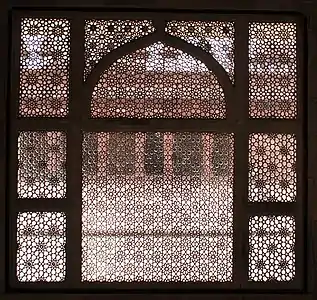
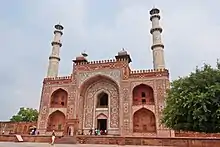 Akbar's Tomb at Agra, India, uses red sandstone and white marble, like many of the Mughal monuments. The Taj Mahal is a notable exception, as it uses only marble.
Akbar's Tomb at Agra, India, uses red sandstone and white marble, like many of the Mughal monuments. The Taj Mahal is a notable exception, as it uses only marble.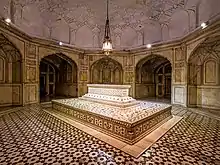
 Tomb of Nithar Begum at Khusro Bagh, Allahabad, India.
Tomb of Nithar Begum at Khusro Bagh, Allahabad, India. One of the Tombs of Ustad-Shagird, Nakodar, India.
One of the Tombs of Ustad-Shagird, Nakodar, India.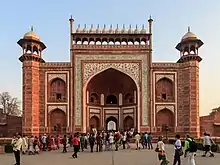 The Darwaza-i-Rauza (Great Gate) of the Taj Mahal.
The Darwaza-i-Rauza (Great Gate) of the Taj Mahal.

.JPG.webp) Diwan-i-Khas (Hall of private audience) at Lahore Fort.
Diwan-i-Khas (Hall of private audience) at Lahore Fort..jpg.webp) Shah Jahan Mosque in Thatta, Pakistan. The mosque is not built in the Mughal style, but reflects a heavy Persian influence.
Shah Jahan Mosque in Thatta, Pakistan. The mosque is not built in the Mughal style, but reflects a heavy Persian influence.
See also
References
- 1 2 "Taj Mahal World Heritage". UNESCO World Heritage. Centre. Archived from the original on 1 February 2018. Retrieved 31 December 2018.
- 1 2 Meri, Josef W., ed. (2005). Medieval Islamic Civilization: An Encyclopedia. Routledge. p. 91. ISBN 978-1-135-45596-5.
- 1 2 3 4 Asher 1992, pp. 1–2.
- 1 2 3 4 5 6 7 8 9 10 11 12 13 14 15 16 17 18 19 20 21 Petersen, Andrew (1996). "Mughals". Dictionary of Islamic architecture. Routledge. pp. 199–205. ISBN 9781134613663.
- ↑ M. Bloom, Jonathan; S. Blair, Sheila, eds. (2009). "Architecture; VII. c. 1500–c. 1900; D. India.". The Grove Encyclopedia of Islamic Art and Architecture. Oxford University Press. ISBN 9780195309911.
- 1 2 3 Vaughan, Philippa (2011). "Indian Subcontinent: from Sultanate to Mughal Empire". In Hattstein, Markus; Delius, Peter (eds.). Islam: Art and Architecture. h.f.ullmann. pp. 464–483. ISBN 9783848003808.
- 1 2 3 4 5 6 7 Asher, Catherine B. (2020). "Mughal architecture". In Fleet, Kate; Krämer, Gudrun; Matringe, Denis; Nawas, John; Rowson, Everett (eds.). Encyclopaedia of Islam, Three. Brill. ISSN 1873-9830.
- 1 2 3 Bloom & Blair 2009, Mughal.
- 1 2 3 4 5 6 7 8 9 Bloom & Blair 2009, Architecture; VII. c. 1500–c. 1900; D. India.
- ↑ Martínez d'Alòs-Moner 2017, pp. 30–33.
- ↑ Burton-Page, John (2008). Indian Islamic Architecture: Forms and Typologies, Sites and Monuments. Brill. p. 36. ISBN 978-90-04-16339-3.
- ↑ Dadlani, Chanchal; Sharma, Yuthika (2017). "Beyond the Taj Mahal: Late Mughal Visual Culture". In Flood, Finbarr Barry; Necipoğlu, Gülru (eds.). A Companion to Islamic Art and Architecture. Wiley Blackwell. p. 1057. ISBN 978-1-119-06857-0.
- ↑ Fatehpur Sikri was once a Jain pilgrimage centre: Book. 27 February 2013.
{{cite book}}:|work=ignored (help) - ↑ "Excavation at Akbars fort at Fatehpur Sikri reveals flourishing Jain and Hindu habitation". Retrieved 15 December 2017.
- ↑ "Fatehpur Sikri was once a Jain pilgrimage centre: Book". hindustantimes.com/. 27 February 2013. Retrieved 15 December 2017.
- ↑ Gupta, Fathepur Sikri:Akbar's Magnificent City on a Hill, pp. 146.
- 1 2 3 Khan, Ahmad Nabi (1970). Pakistan archaeology no.7. pp. 121–122, 126.
- ↑ Koch, Ebba (1990). Mughal architecture. p. 83.
- ↑ Schimmel, Annemarie; Waghmar, Burzine K. (2004). The empire of the great Mughals : history, art and culture. Internet Archive. London : Reaktion Books. p. 148. ISBN 978-1-86189-185-3.
- 1 2 Wheeler, R. E. M. (1950). Five thousand years of Pakistan. p. 83.
- 1 2 Asher 1992, p. 116-117.
- ↑ "The mosque that Jodha Bai built". Daily Times. 26 June 2004. Retrieved 5 June 2013.
- ↑ Janin, Hunt (2006). The Pursuit of Learning in the Islamic World, 610-2003. McFarland. p. 124. ISBN 978-0786429042. Retrieved 17 November 2021.
- ↑ Indian Journal of History of Science, Volume 44, Issues 1-3. National Institute of Sciences of India. 2009.
- ↑ The Sikh Courier:Volumes 9-12. Sikh Cultural Society of Great Britain. 1977. p. 16.
Nadir-ul-Asar Ahmad Mimar Lahori Shahjehani was also a Punjabi who designed the Taj Mahal of Agra
- ↑ History and Civis. S. Chand Publishing. p. 226.
- ↑ Ahsan Jan Qaisar, Saiyid Nurul Hasan, Som Prakash Verma (1993). Art and Culture: Felicitation Volume in Honour of Professor S. Nurul Hasan. Publication Scheme. ISBN 9788185263823.
{{cite book}}: CS1 maint: multiple names: authors list (link) - ↑ "Conservation of the Wazir Khan Mosque Lahore: Preliminary Report on Condition and Risk Assessment" (PDF). Aga Khan Development Network. 2012. Archived from the original (PDF) on 27 August 2016. Retrieved 25 August 2016.
The Wazir Khan Mosque was built in 1634-35 AD (1044-45 AH), by Hakim 'Ali ud din* a governor of Punjab in the early part of the reign of the Mughal emperor Shah Jahan.
- ↑ Masson, Vadim Mikhaĭlovich (2003). History of Civilizations of Central Asia: Development in contrast : from the sixteenth to the mid-nineteenth century. UNESCO. ISBN 9789231038761.
- ↑ "Walled city of Lahore conservation". Retrieved 25 August 2016.
The Walled city of Lahore is famous for several historic monuments including the Lahore Fort – a World Heritage site, the Badshahi, and Wazir Khan mosques. Close to 2,000 buildings within the Walled city display a range of architectural features that mark Lahore's centuries-old cultural landscape. A majority of these buildings and the mohallas (local neighbourhoods) in which they are situated form a unique heritage footprint. The work consequently carried out by the Aga Khan Trust for Culture (A.K.T.C.) and the Aga Khan Historic Cities Programme (AKHCP) was initiated under a 2007 public-private partnership framework agreement with the Government of Punjab.
- 1 2 "Fort and Shalimar Gardens in Lahore". UNESCO. Retrieved 4 January 2017.
- ↑ REHMAN, A. (2009). "Changing Concepts of Garden Design in Lahore from Mughal to Contemporary Times". Garden History. 37 (2): 205–217. JSTOR 27821596.
- ↑ Shalamar Gardens Gardens of the Mughal Empire. Retrieved 20 June 2012
- 1 2 3 Khazeni, Arash (2014). Sky Blue Stone: The Turquoise Trade in World History. Univ of California Press. ISBN 9780520279070. Retrieved 16 July 2017.
- ↑ "Shah Jahan Mosque, Thatta". UNESCO World Heritage Centre. Archived from the original on 3 October 2018. Retrieved 31 December 2018.
- ↑ Asher 1992, p. .
- ↑ Asher 1992, p. 225.
- ↑ Shelomo Dov Goitein. Studies in Islamic History and Institutions BRILL, 2010 ISBN 9004179313 p 170
- ↑ "Masjid Vazir K̲h̲ān". Archnet. Retrieved 25 August 2016.
The mosque was founded by Hakim Ilmud Din Ansari, a distinguished physician from Chiniot who received the Ministerial title of 'Wazir Khan' under the reign of Shah Jahan, and was later promoted to the position of Viceroy of Punjab.
- ↑ "History and Background in Conservation of the Wazir Khan Mosque Lahore: Preliminary Report on Condition and Risk Assessment". Aga Khan Historic Cities Programme. Aga Khan Cultural Services - Pakistan. 2012. Retrieved 25 August 2016.
The spectacular monumental ensemble of the Wazir Khan Mosque in the Walled City of Lahore was built in 1634 during the reign of the Mughal emperor Shah Jahan.
- ↑ UNESCO World Heritage Centre. "Badshahi Mosque, Lahore – UNESCO World Heritage Centre". Whc.unesco.org. Retrieved 2 January 2014.
- ↑ REHMAN, ABDUL (2009). "Changing Concepts of Garden Design in Lahore from Mughal to Contemporary Times". Garden History. 37 (2): 205–217. ISSN 0307-1243. JSTOR 27821596.
Sources
- Asher, Catherine Blanshard (1992). Architecture of Mughal India. The New Cambridge History of India, Part I. Vol. 4. Cambridge University Press. ISBN 9780521267281. Retrieved 16 July 2017.
- Bloom, Jonathan M.; Blair, Sheila (2009). The Grove Encyclopedia of Islamic Art & Architecture. Oxford University Press. ISBN 978-0-19-530991-1. Retrieved 15 March 2013.
- George Michell, Amit Pasricha (2011). Mughal Architecture & Gardens. Antique Collectors' Club. ISBN 9781851496709.
- Gupta, Subhadra Sen; Irani, Prakash (2013). Fathepur Sikri: Akbar's Magnificent City on a Hill. Niyogi Books. ISBN 9789381523728.
- Martínez d'Alòs-Moner, Andreu (2017). "The Infrastructure of the Mission: Convents, Palaces, and Temples". In Andreu Martínez d’Alòs-Moner, Victor; De Torres, Jorge; Martínez d'Alòs-Moner, Andreu; Cañete, Carlos (eds.). The Archaeology of the Jesuit Missions in Ethiopia (1557–1632). Brill. ISBN 9789004324695.
.jpg.webp)

.jpeg.webp)
.jpg.webp)
